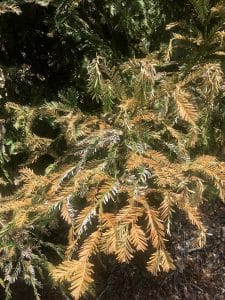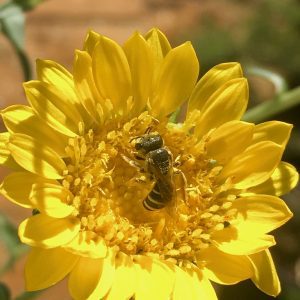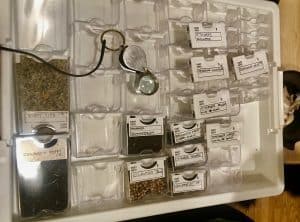Some like it hot. And some do not. California’s native flora is perfectly adapted to California’s climate, environmental conditions, soils, and microclimates. And natural gardens are too… except that when we get a day (July 6, 2018) that breaks all high temp records, we learn that desert plants thrive, natives from hot dry environs do fine, and many coastal plants including manzanita and Ceanothus do better in shade. In summer think Shade. In the “new” California, think Shade. Shade for the plants, shade made by the plants’ branches for their own root zones, and shade for all critters great and small. Even when you explore huge fields of immense boulders in our scorching desert mountains, you will always find the most abundant life in the shade of some big rock.

History, review, current affairs
Oh man, a few of those extremely hot days last month really took their toll on the southern California landscape. Lots of conifers, for example, many mature Canary Island pines (not California natives) all over the land are now burnt crisp on their south and west sides. New growth got singed on plants throughout southern California on July 6, when we hit a record of 118° here at Tree of Life Nursery. Not surprisingly, we sustained some damage to a few of our landscape specimens (come see our 60’ coast redwoods), but virtually no damage to our container stock. We were diligent with watering, mostly in preparation for this extreme heat. Hopefully you and your gardens are OK. Take heart, your plants will outgrow any tip burn they may have endured.
Watering
How you water in August is related to how you have been watering since May. If you have been giving your garden the recommended deep irrigation (equiv. 1.5-2” precip.) every 3-4 weeks, using the early morning cycle/soak method (applying water 3 consecutive days to achieve the cumulative total), coupled with an occasional early evening refreshing sprinkle (2-3 times/week), thus cooling the garden and wetting the leaves without actually watering the roots, then you and your garden are able to take summer heatwave events in stride. All is well. For a review on summer water see July in the Natural Garden 2018 and Watering Native Plants if these methods are new to you, you have some catching up to do so you can apply water correctly over the next 2-3 months.
Native plants have developed many strategies for survival during the hot, rainless period. One such is making deep roots. Do not imagine that you water to provide for the plant’s needs. You water the soil. The plant uses water according to its needs, and roots need to be able to find water and nutrients in the soil. Your job is to put water into the soil at optimum root depth (12-18”), and maintain a consistent moisture level down there so roots can find water whenever the plant needs it. But not only water. Roots need oxygen too. That’s why you are to water with deep and infrequent irrigations, so air will follow the water down into the soil.
And have fun with those evening-time refreshing sprinkles. It’s a good moment at the end of a hot day for both you and your natural garden. Turn the hose straight up and take a front yard, (fully clothed) shower. Very cool. Make your neighbors jealous of both your natural garden and your natural lifestyle.
Related to Watering
Many of the best natural gardens are found in neighborhoods where (regrettably) the neighbors are over watering their inappropriately thirsty gardens, and consequently their runoff, soil moisture, surface water, algae, moss, and overspray come into the natural garden, causing a wet zone, usually on an edge. Two solutions for you: 1) show your beautiful natural garden to your neighbor and explain that they can have one too, benefiting wildlife and the environment, or 2) plant fast growing moisture loving plants on the wet edge and take advantage of the free bog your neighbor is giving you. We can help with both 1 and 2.
Pruning
August is too early to significantly shape and prune plants, other than removing dried seed heads. If you have dead branch tips from the July heat waves, best to leave them in place on the plant. Though unsightly, they are shading and protecting the tender buds and leaves below them. If they do not break off and blow away themselves by September, you can break them off with your fingers. If you have highly visible specimens that need a little grooming right now, go ahead. The best technique is to break off the dead tips, rather than to open a wound by cutting into green wood with clippers.

Weeding
Watch for seed heads. If you have been on top of weeds through spring and summer, you now have a weed free garden, as the long days of summer are not typically conducive to seed germination. Spotted spurge is an exception. It loves hot weather.
Mulching/Top dress
In summer, less is best. Assuming your garden is well acclimated and has acquired its own brand of “sturdiness,” you do not need to be very active with garden chores. Come fall, you can get in there and refresh everything, do a little pruning and shaping, and revitalize your mulch or top dressing. Not now. Keep your existing mulch/top dress cool with your evening refreshing sprinkles a couple times a week.
Feeding
No feeding or fertilizer in August.
Troubleshooting – Varmints, Pests and Diseases
Of course bunnies are especially hungry and thirsty right now as the babies are all grown up and will be looking to set out on their own. Shoo them away unless you have enough green growth for everyone. Pray for success for the hawks and owls. Gophers never give up so you cannot give up either. Insect populations (injurious plant pests) will be kept in check by natural predators in a sustainable garden. If you see boom outbreaks of say, aphids on the new growth of milkweed, inspect for ladybug larvae and other beneficials. If they are not there, you can blast the aphids off with a strong stream of water through a nozzle. Avoid inducing root rot disease which can become a problem if you water incorrectly.

Annual Wildflowers
No seed sowing at this time. Collect seed from spent blooms from last spring. Clean and categorize them. This is a fun activity.
Adding New Plants
Desert lavender, jojoba, chuparosa, acalypha, golden bush, Indian mallow, fairy duster, Great Basin sagebrush, desert mallow and our increasingly large selection of heat-loving desert and desert-edge plants can be successfully planted during the warm season. They like it hot. We are growing more than ever. Simply avoid extremely hot days for handling, and give them a little extra care through the summer so that the root balls do not dry out. Stop by to see the heat-lovers in person, many of which are extremely aromatic. If plants can adapt, so can we.
Engage
On a hot day, take a deep breath. The scents and aromas exuding from your natural garden actually define the concept of aromatherapy. Pick a few leaves, dry and crush them to make a potpourri. Bring a few stems of your favorite scented natives indoors for a flower arrangement in a vase, i.e., California bay, sage, desert lavender, sagebrush, and even our humble mulefat. Or, on a hot day, take a big drink. Ice water infused with leaves and flowers of wooly blue curls, yerba buena, desert lavender or coyote mint… just a hint of plant flavor. Simply float a few cuttings in the water and imagine you are camped at a cold water, plant lined, spring fed stream. That’s one way to beat the heat!
From the Garden, and Hot Summer!
Mike Evans
Questions? Help is just one call or one email away. Call (949) 728-0685 or email (with pictures if you like) our special helpline: gardenhelp@californianativeplants.com